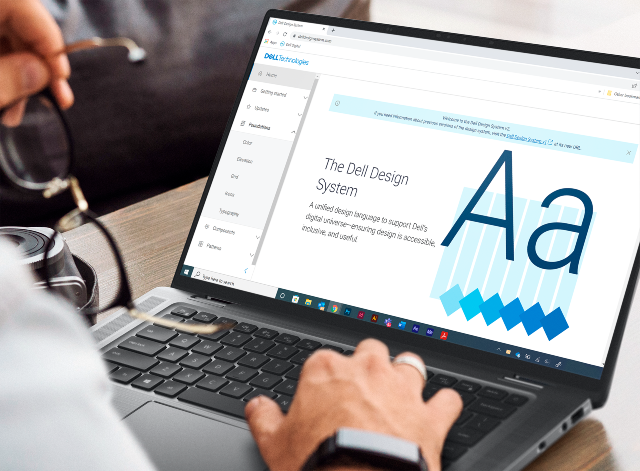Whether customers are buying a single personal PC or upgrading to storage-as-a-service across their IT organization, a modern, clean digital design, consistent look and feel and easy navigation are essential to how they feel about the experience, the product and your company. At Dell Digital, Dell’s IT organization, we are in the middle of an evolution to better connect our products to the humans who use them.
Our effort began with a simple mandate—unify our digital experience ecosystem and reduce confusion for our customers.
Like many longstanding companies, Dell has grown and matured its business over the years from being primarily a hardware company that allowed great customization and flexibility to a leader in software services and infrastructure. Because of that, we have thousands of digital experiences out there across different URLs and domains that we own as a company which do not reflect who we are today.
We started by building a modern design practice that would standardize our digital experience—the look and feel, basic interaction patterns, palette and colors that reflect our brand. Our efforts to institutionalize our design have led to a broader mission that is still underway to create a unified customer experience across Dell.
Three years into the process, we’ve built a design system that is reusable, measurable and delightful. We’ve increased customer engagement and improved our navigation structure. We’ve baked accessibility into our design system and are working to integrate it seamlessly into our developer experience. Our customer satisfaction (CSAT) reached an all-time high across all experiences. And our transformation is continuing.
First part of the puzzle
We initiated the process by focusing on evolving our design language system, which contains the core design and code components that our company uses to build our digital experiences. Dell had a nascent design system in place which provided a foundation. We built a new platform, the Dell Design System, on Dell products and using a complete Dell infrastructure and latest technologies to host an evolved experience.
The Dell Design System is the first part of the puzzle toward creating a unified customer journey but it’s not the whole puzzle. It defines key digital elements, like buttons, modal windows, carousels, page headers and footers. It also standardizes topography and font for consistency.
Those components make up the larger patterns for our digital ecosystem. Designers and engineers can access the components via a repository of code and design elements that also support UI and dev kits at delldesignsystem.com. They can also use micro front ends (MFEs), webpage components, building blocks that can be plugged into a page, or unplugged, to quickly construct the consistent look and feel for the customer experiences we want. MFEs use the Dell Design System and are stored in a UX marketplace.
An important part of the Dell Design System is its focus on inclusive design to ensure we are building products for people of all abilities using the World Wide Web Consortium international guidelines. We have an accessibility team review all components before they are added to the design system for compliance. I’ll talk more about this in a future blog post.
Among the reasons for institutionalizing design systems is the need to tackle common software development challenges. With standardized, repeatable code, developers and engineers don’t have to reinvent the wheel every time they need to include a common feature. After all, nobody needs to create the same three address fields over and over. Using our design system, developers can build best-in-class, consistent designs like mastheads and footers fast. They can turn Dell blue to Dell purple in an instant.
The Design System not only creates consistency, but it also accelerates time-to-market. We are all aligned in a beautiful, consistent experience.
And, of course, a single design system means we can give the many sites across the company a unified, recognizable look and feel and a more user-friendly, modern design. We are transforming the aging experiences that don’t reflect the current impetus of the company or provide the information that customers are coming to find into those that do.
Dell has always had great industrial designers, as reflected in our products. We are now extending that excellence to our digital spaces.
We launched the first generation of our design language system two years ago, focusing on how to put the building blocks together. We then started to evolve it to define where we want to go for our recently launched second generation and beyond.
Because the Design System reflects what’s happening in the products themselves, we work closely with product teams to meet their needs. It’s a true collaboration model that encourages users to contribute back into it.
Among the challenges we face is how to achieve commonality in a company that uses multiple solutions across multiple platforms. One way is to provide generic versions of the cascading style sheets and JavaScript. Another is by building kits for developers and designers to help them implement this into the actual applications they use to either code or design.
 Building a design culture
Building a design culture
A crucial part of our design transformation is to add more designers into the development process and clearly define their roles. This is part of what we call the Dell Digital Way—a balanced team made up of design, engineering and product management.
When my team began its design transformation effort, Dell was already using an agile development methodology to create software via microservices rather than the traditional monolithic approach to development. Small balanced teams worked with business users to frame, write and test human-centered solutions and iterate on them based on real-time feedback. However, designers were either brought in at the end of the process or had more of a consultant role, rather than being on the team.
We had a small collection of good designers who were used more as consultants. So, we started with identifying and creating job descriptions for designers and placing them in appropriate product teams.
Together with engineers and product managers, designers help identify the problems humans may have, research behavioral drivers, identify and research the competitive landscape and articulate the measures of success. Having designers on development teams from the start has resulted in measurable improvements in customer usability, as indicated by such metrics as higher scores in customer satisfaction, customer effort, time to interact, churn rate and customer loyalty.
We have expanded our designer ranks four-fold over the past three years and are still striving to add designers to every product team.
We are also working to expand the use of our design language system in our products, a crucial part of our modern design transformation over time.
Understanding our users
Design is much more than visual. Without understanding the motivations and needs of the humans using your products, you’re never going to design the best user experience. We use a variety of measurements as well as behavioral science to gain that understanding.
We are also striving to achieve unified customer experience that goes beyond creating standardized design and easy to use websites for users. That means accommodating the various roles and different journeys customers take in their digital experience with Dell.
What it boils down to is connecting products to the humans who use them. Design is the bridge to helping understand how customers are emotionally connected with the way they access and use products, which translates into lifetime value and loyalty.
As we continue our efforts, I will share what we learn with you in this space. Be sure to check out my next blog offering more details on how we are working to understand our customers with evolving measurement tools as well as behavioral science.


